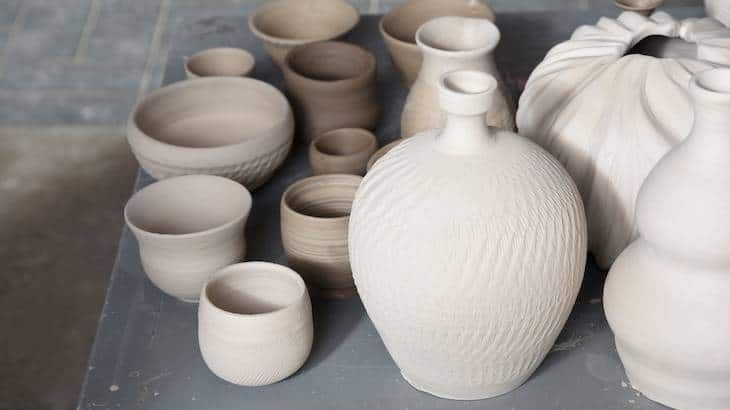Which Is Better Ceramic Or Porcelain Mugs?
Ceramic and porcelain are both clay-based materials that are commonly used to make mugs. Ceramic is a broad term that encompasses all pottery made from clay and hardened by heat, including porcelain. Porcelain is a specific type of ceramic that is made from finer clay and fired at higher temperatures than regular ceramic (Source).
When choosing between ceramic and porcelain mugs, there are a few key factors to consider: durability, heat retention, appearance, and cost. Porcelain is generally more durable and has better heat retention properties than ceramic. However, ceramic mugs can have more varied shapes, textures, and decorative patterns. Porcelain mugs tend to be more expensive due to the higher quality materials and production process (Source). This article will compare ceramic and porcelain mugs across these factors to help determine which material may be better for different uses and preferences.
Manufacturing Process
Ceramic mugs are made from natural clay that is shaped and then fired at high temperatures to harden it. The clay goes through a process called vitrification where it becomes a non-porous material after being fired at temperatures between 1000-1300°C. Water is added to the clay to make it malleable so it can be worked into the desired shape for the mug. Once shaped, the mugs are loaded into industrial kilns and fired to permanently harden them.
Porcelain mugs are also made from clay but with the addition of feldspar and fired at even higher temperatures between 1200-1400°C. The feldspar lowers the firing temperature and allows porcelain to become translucent and take on a smooth white appearance. The manufacturing process starts with mixing the clay, feldspar, and water into a slurry. This liquid mixture is poured into plaster molds to form the mug shapes. After drying, the porcelain mugs are glazed for an impermeable and glossy finish. They are then fired at the high temperatures which vitrifies the clay into hardened porcelain.
Sources:
Industrial Processes to Make Ceramic Cups
Porcelain vs. Stoneware: What’s the Difference?
Durability

When it comes to durability, porcelain mugs are generally considered more durable and less prone to chipping or breaking compared to ceramic mugs. This is due to the denser composition and higher firing temperature used to create porcelain (Source 1).
The clay composition of porcelain is finer and more tightly packed. This dense structure makes porcelain harder and less porous than ceramic. Ceramic mugs tend to be more porous and brittle, so small cracks or chips can spread more easily (Source 2).
Porcelain’s high firing temperature results in a mug that is up to 50% stronger than ceramic. The intense heat vitrifies the clay into a tougher material that is less prone to chipping from impacts or drops. In contrast, the lower firing temperature of ceramic mugs makes them more susceptible to cracks and breaks.
While ceramic mugs can develop small hairline cracks over time with use, porcelain mugs are engineered to withstand more wear and tear. So if durability is a key factor, porcelain mugs tend to be the better choice.
Heat Retention
When it comes to retaining heat, porcelain mugs have the advantage over ceramic mugs. Porcelain is denser and has a smoother surface, allowing it to retain heat longer. The thicker walls of porcelain mugs prevent heat from dissipating quickly.
According to Kulture Hub, “Porcelain mugs have excellent heat retention properties, keeping your beverage hot for longer periods. Ceramic mugs, although they can also retain heat well, may not keep a drink hot as long as porcelain.”
Longhui Ceramic notes that because of their thick sides, porcelain mugs “retain heat longer than other mugs.” So if keeping your coffee or tea hot is a priority, porcelain is generally the better choice.
Appearance
Ceramic mugs come in a much wider variety of colors, patterns, and designs compared to porcelain mugs. The clay used to make ceramic mugs can be tinted and mixed with pigments to create vibrant colors like bright reds, greens, and blues that are not possible with porcelain. Ceramic artists also have more flexibility when adding painted designs, textures, and decorative effects to the surface of ceramic mugs. This allows each ceramic mug to have a unique, handcrafted look. Porcelain mugs tend to be limited to white or solid light colors like gray or beige. Hand-painted designs can be added to porcelain, but the color palette tends to be more subtle. For those who want a mug with an intricate pattern or bold, saturated colors, ceramic offers far more options for creative and eye-catching styles. According to Pinterest, ceramic mugs are sought-after for their “handmade” and “creative” designs (https://www.pinterest.com/seanindundee/1000-ceramic-cups-and-mugs-handmade/).
Texture
Porcelain tiles tend to have a smoother, less porous texture than ceramic tiles. The denser composition and higher firing temperatures used for porcelain result in a tighter, less permeable surface [1]. Some varieties of ceramic can have a more noticeable grainy or pitted texture. This rougher surface makes ceramic potentially more prone to absorbing liquids and staining over time.
The smooth texture of porcelain gives it a refined, elegant aesthetic in many applications like bathrooms and kitchen backsplashes. However, the surface of ceramic can provide more traction underfoot in wet areas like showers. The choice between porcelain and ceramic texture often comes down to the visual look you want to achieve and where the tile will be installed.
Weight
Porcelain mugs tend to be lighter and more delicate than ceramic mugs. According to Kulture’s blog post “Porcelain or Ceramic? Know Your Coffee Mug Material for the Best Drinking Experience,” porcelain has a finer structure and is thinner than ceramic, resulting in a lighter weight mug (https://www.linkedin.com/pulse/porcelain-ceramic-know-your-coffee-mug-material-best-kulture). Unifury also notes in their post “Porcelain vs Ceramic Mugs: Which is the Best?” that ceramic mugs can be quite heavy, especially when filled, due to their thicker walls and heavier material (https://unifury.com/blogs/gifting-guide/porcelain-vs-ceramic-mugs). The lighter weight of porcelain makes it easier to handle and lift compared to bulkier ceramic mugs.
Cost
Ceramic mugs are generally less expensive than porcelain mugs. Ceramic mugs can range from $1-$15, while porcelain mugs are typically $15-$50. The higher cost of porcelain is due to the more complex manufacturing process and higher quality materials used.
“Price range: Porcelain mugs are often associated with higher-end or specialty products and tend to be more expensive compared to ceramic mugs. …” (Source)
Cleaning
Both ceramic and porcelain mugs should be handwashed to preserve their quality and appearance. However, porcelain often requires a bit more care when cleaning.
Porcelain’s smooth, glasslike surface makes it prone to staining from coffee, tea, and other beverages. To remove stains, some gentle scrubbing with a soft cloth or sponge may be needed. Avoid abrasive scouring pads or powders, which can scratch the surface. For tough stains, a paste of baking soda and water can help lift discoloration without damaging the mug.
The more porous nature of ceramic makes it generally easier to clean. However, acidic drinks like coffee can stain the absorbent material over time. Use a mild detergent and warm water for cleaning. Baking soda or a non-abrasive ceramic cleaner can tackle set-in stains.
With proper care, both ceramic and porcelain mugs can last a long time. But porcelain’s delicate surface means a bit more caution should be used when washing to prevent scratches or damage.
Conclusion
In summary, the main differences between ceramic and porcelain mugs are:
Ceramic
- More porous material
- Lower durability
- Better heat retention
- Rougher texture
- Heavier weight
- Lower cost
Porcelain
- Less porous material
- Higher durability
- Poorer heat retention
- Smoother texture
- Lighter weight
- Higher cost
When choosing between ceramic and porcelain mugs, consider how you plan to use it. Ceramic works better for drinking hot beverages, while porcelain is ideal if you want a lightweight, durable mug for daily use. Porcelain also has a more elegant look if aesthetics are important. Evaluate your priorities and intended use to decide which material suits your needs.



